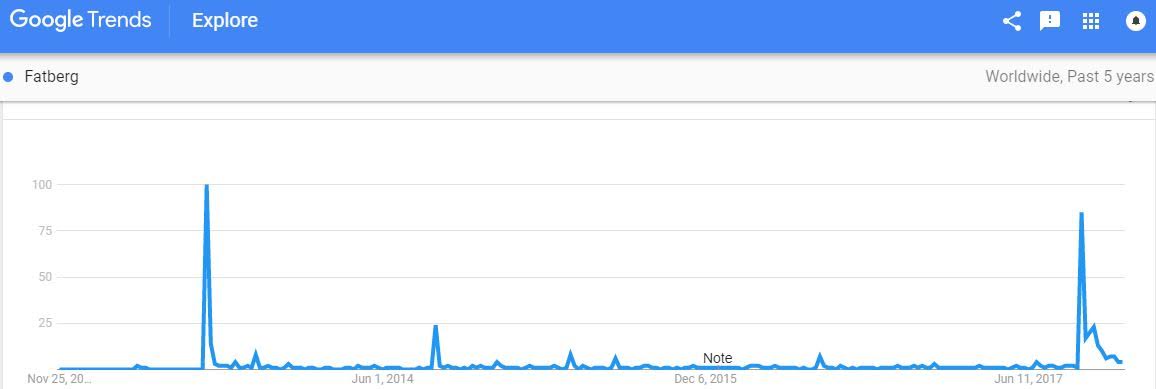Warning - monster fatberg alert!
Thursday, 23 November, 2017
A huge fatberg was discovered by Thames Water in a sewer under Whitechapel Road, London in September 2017. While we highlighted in our (opens in a new window)review paper that a fatberg is not a new phenomenon, there was much media attention about the “monster” fatberg – 130 tonnes (“weighing the same as 11 double decker buses”) and 250 metres long (“stretching the length of two football pitches”). The removal or “defeat” of the fatberg was celebrated in the international (opens in a new window)media nine weeks later. Although the Museum of London requested a part of the fatberg for display, the recovered material was sent for processing into biofuel as was described in a previous BBC radio (opens in a new window)story. Not surprisingly, the public interest in fatbergs peaks when major blockages occur as can be seen in the Google Trends graph for the last five years.

Meanwhile, back on the Fulbright project, I had planned to concentrate on a desktop study for my visit to the US and did not anticipate that I would get much of an opportunity for practical testing of sensors in sewers. However, due to a discussion I had with a fellow Fulbright Awardee, Dr Jacek Kibilda, I was put in contact with the CONNECT Centre in Trinity College Dublin (TCD) where I have received excellent practical assistance on sensors from Albert Baker in particular. My original proposal was to investigate low cost sensors which could transmit data from sewers over the “Internet of Things” (IoT) network. As it turns out, the CONNECT centre has a Science Foundation Ireland funded project called (opens in a new window)Pervasive Nation which aims to roll out IoT networks across each third level campus in Ireland. Seeing as TCD had a gateway installed on campus, we did an initial signal transmission test under a manhole cover using existing commercially available sensors (e.g. temperature and humidity); this proved to be a success and it was suggested that it may be possible to achieve a 2 km range with IoT gateways collecting data from sensors within sewers.
Since then, I have been exploring potential locations for installing sensors on the UCD campus because there is now an IoT gateway in operation in recent months. The staff in (opens in a new window)UCD Estate Services have been helpful with this proposal, so I am hoping to carry out some trials in the coming months using ultrasonic sensors. In the meantime, I am advising anybody who listens what to do with grease residues from Thanksgiving and Christmas dinners – I am hoping there will not be any monster fatberg alerts although on the otherhand, this could be useful to verify if my project works!